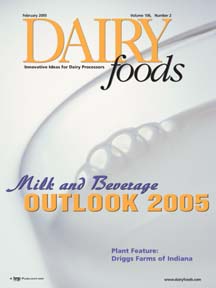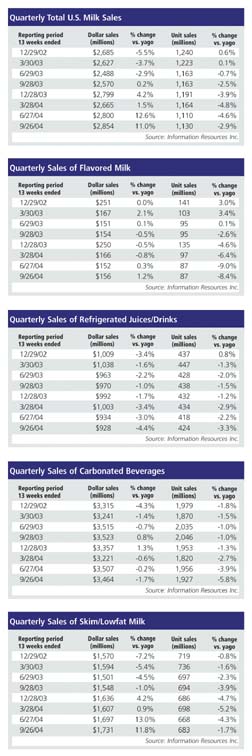
Ten years from now those in the industry may look back on 2004 and recall the first time they saw a bright, backlit McDonald's menu board promoting milk in the McDonald's Milk Jug.
Will 2005 have the same resonance? Some in the industry believe 2005 could be made equally memorable as the year that school milk programs learned a lesson from Ronald McDonald.
Another take on 2004 might be that it was the year when the dairy industry convinced American consumers that they can lose weight while drinking milk. Recollections of 2005 will undoubtedly include the new USDA Dietary Guidelines, which may have the effect of a government stamp of approval on the industry's 3-A-Day promotion.
The stars may be lining up, and milk could be the shining star of the beverage category this year.
A year ago, Dairy Foods forecasted a wild ride for milk sales (and for the entire beverage industry) in 2004. And we had no idea that milk prices would jump like they did and that McDonald's and Wendy's would be so successful in their serious efforts to sell more milk. Last year we also noted that it had been more than a year since the Los Angeles Unified School District has restricted sales of soft drinks in its schools. Many are still wondering when dairy processors will take advantage of this opportunity, and some disagreement is brewing over what should be done about it.
Carb-counting dieters were rocking the boat in 2004, but in 2005 trend spotters are reporting a tremendous hissing sound as the low-carb balloon deflates. Organic dairy is hotter and more competitive than ever.
We'll talk about what the industry promotion groups have planned, look at some product and business launches that will impact beverage sales in 2005, and make some bold predictions, but first let's look at the most recent numbers.

Ups and downs
The most complete picture of overall milk sales comes from USDA, and the most recent full-year numbers available are for 2003. Sales were down 0.5% after having gained about the same amount in 2002. Up and then down.More recent numbers are offered by Information Resources Inc., Chicago. IRI's numbers reflect supermarkets, drugstores and most mass merchandisers, but do not capture foodservice, convenience stores or Wal-Mart.
For the first three quarters of 2004 unit sales of milk slowed significantly while dollar sales grew (by as much as 12.6% in the 13 weeks ended June27) as the escalating price of raw milk was passed on to consumers. Dairy processors may well remember 2004 as a year when raw milk prices rocketed out of a year-long slump to the point where they impeded efforts to sell more milk.
Flavored milk has been such a strong performer in recent years, that some in the industry speculated it might be able to float the entire category. But with Americans paying closer attention than ever to carbohydrates and calories, flavored milk sales stagnated and then shrank in 2003 and 2004.
Milk's not alone in facing a hard battle for share of stomach. For the past two years, other beverages, including soft drinks and juice, have been losing out to the most basic bottled beverage of all-water. In 2004 sales of bottled water continued to grow and outpace those of other beverages.
Unit sales of carbonated soft drinks were off between 2.7% and 5.8% in the first three quarters of 2004. Unit sales of refrigerated juices and juice drinks were down 2.9% to 3.3% during the same period. Both of these categories suffered losses without any significant changes in consumer prices.
Once again, most of these figures are from IRI and do not capture foodservice or convenience store sales. To illustrate the importance of that, USDA numbers for 2003 show an increase in flavored milk sales compared to the decreases seen in IRI scanner data. But even USDA's numbers show growth that was less pronounced than in previous years.
Another telling figure that the industry often frets about is per-capita consumption. The USDA tracks this figure from 1980 forward. Total annual milk sales have declined from 233.7 lbs per person in 1980 to 185.9 lbs in 2003. When this data was looked at last year, it appeared that per-capita shrinkage was slowing. The number dropped to 188.5 from 189.6. But from 2002 to 2003 it dropped from 188.5 to 185.9. And with the spike in milk prices experienced last year, it's a safe bet that per capita-figure will drop again when the 2004 statistics are revealed.
Vending sales showed a bit of twinkle in 2003. With the same number of machines in operation as 2002 (roughly 80,000) sales increased both in terms of units and dollars. Dollar sales, at $493 million, were higher than they have been in the past 10 years and nearly $50 million higher than in 2002.
The most promising numbers in 2004 came from an arena where milk sales are typically hard to quantify-food service. In particular, McDonald's, of Oak Brook, Ill., and its nearest competitor in the burger business, Wendy's of Dublin, Ohio, worked with Dairy Management Inc., to implement a program that repackaged the milk itself and the in-store presentation of milk. The results were flabbergasting.
McDonald's sales nationwide jumped from 625,000 units a week to more than 4.2 million units a week within less than two months after the new package and promotional efforts were introduced.
The growth has been so dramatic, processors are scurrying to add capacity to keep up with demand, says Tom Gallagher, CEO of Dairy Management, Inc.
"Other chains will follow suit with 8 oz packages and we are working on getting the 16 oz packages in (to McDonald's and Wendy's)," Gallagher says. "At the rate they are going, they could yield easily a billion lbs of extra milk sales a year."
That equals nearly a 2% jump in the 54 billion lbs sold in the United States in 2003.
Takin' ‘em to school
Vending and foodservice are two non-core channels that offer great opportunity for increased sales. But the school a la carte line may be the most important to the future of the milk industry.This year DMI is working to encourage processors to improve school milk in two ways-by offering more flavors and by switching from paperboard cartons to resealable plastic bottles, just as McDonald's and Wendy's have done.
"People always want to do studies," Gallagher says. "But we know we went from seven cardboard cartons a week per store to 300 per store. That's the study."
DMI has evidence too that the phenomenon will transition from the golden arches to the school cafeteria.
Several processors including HP Hood, National Dairy Holdings, and Dean Foods, began to offer plastic bottles in their school programs, in 2003. The New Look of School Milk (NLSM) pilot program (see story p. 32) offered better flavors, plastic packaging, and in some cases, larger package sizes, and the results were remarkable. Currently plastic packaging is in about 1,500 of the nation's 90,000 schools, but Gallagher says that's up from virtually zero a few years ago.
Within the industry there is some debate as to how tightly school milk improvement efforts should be focused.
"Our take on schools is a little broader than simply the packaging," says Tom Nagle, v.p. of marketing at the International Dairy Foods Assn. "There are about 15 different things you can do to improve school milk. If you just pick five, you will see very substantial improvements in sales. If you treat it like any other foodservice provider, you will do what you need to do to please the customer."
Indeed, other improvements are being made to school milk. HP Hood offers upgraded flavors in both plastic and a more colorful paper container, and Smith Dairy, Orrville, Ohio, recently developed a no-sugar-added chocolate school milk with 31% fewer calories.
While the a la carte line may hold exponentially more potential for growth, no one is saying that school vending should be ignored either. Recently the Wisconsin Milk Marketing Board boasted that two-thirds of the Dairy State's high schools have milk vending machines. That's a higher percentage than anywhere else in the country.
Organic growth
Last month Organic Valley Family of Farms, La Farge, Wis., announced record sales of $208 million in 2004, up 33% from $156 million the year before."We literally grew 50% more than we expected," said CEO George Siemon.
Organic Valley sells a full line of organic dairy products, but much of its business is milk.
Late last year Stonyfield Farm and HP Hood rolled out Stonyfield Organic Milk which will compete directly with Organic Valley and with Dean's Horizon Organic Milk.
Clearly, organic milk offers a tremendous opportunity for growth. It can also serve as a stopgap to keep consumers from turning away from milk in favor of other beverages.
As the industry seems to have scored a major victory in maintaining or even bolstering milk's image through the weight loss initiatives, one of the few potential hurdles that lie ahead is lactose intolerance. To help clear that hurdle, HP Hood, which manufactures Lactaid under a license from McNeil Nutritionals LLC, has offered Lactaid in the school lunch line in a number of schools in New England. The industry is also working to educate consumers about lactose intolerance and the options available to those who suffer from it.
Just in case the successes at McDonald's and Wendy's are not enough to encourage processors to focus more on foodservice, more research is being offered by a California dairy group. A recent nationwide survey by the California Milk Processor Board (CMPB) concluded that more than half (53%) of parents said they were more likely to go to a restaurant that promotes milk as an alternative to soda. And 63% said milk on the menu was important in deciding where to take their kids out to eat.
"Parents are getting the message that milk - and not some sugary, nutritionally void drink - is best for kids," says Jeff Manning, CMPB's executive director. "Operators need to realize that the milk they already stock can build and retain family business.
"And, milk doesn't have to be white, out of the glass," Manning adds. "Hot chocolate, flavored milks and straws, and real milk-based smoothies or Licuados, are just a few of the ways operators can feature kid-friendly milk-based drinks that give parents what they want."
Looking down the road, Nagle sees the success of the weight loss initiatives reaping greater rewards. He points to an IRI panel survey of 70,000 consumers, where more than 50% said they were aware of the connection between weight loss and dairy and they believe that milk can help them lose weight. He notes that the price spike of milk in 2004 might have kept the good news about milk from paying the kind of dividends that it ultimately will.
Gallagher is certain there is a light at the end of the tunnel, if the industry does what it needs to do. The best opportunity right now, he says, is in improving school milk, and those improvements will have a domino effect.
"If we give them what they want and where they buy it, yes, it is realistic to expect to see the fluid milk category grow."
Questions remain about whether dairy processors have the capacity, or can quickly add the capacity needed to meet the growth that could come from food service. And as for school milk, it is unclear if processors are able or willing to convert school milk programs to something resembling what is being offered to the nation's top burger chains.
No doubt about it, 2005 could be a defining year for milk.